11 start with M start with M
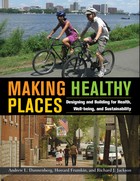
This book provides a far-reaching follow-up to the pathbreaking Urban Sprawl and Public Health, published in 2004. That book sparked a range of inquiries into the connections between constructed environments, particularly cities and suburbs, and the health of residents, especially humans. Since then, numerous studies have extended and refined the book's research and reporting. Making Healthy Places offers a fresh and comprehensive look at this vital subject today.
There is no other book with the depth, breadth, vision, and accessibility that this book offers. In addition to being of particular interest to undergraduate and graduate students in public health and urban planning, it will be essential reading for public health officials, planners, architects, landscape architects, environmentalists, and all those who care about the design of their communities.
Like a well-trained doctor, Making Healthy Places presents a diagnosis of--and offers treatment for--problems related to the built environment. Drawing on the latest scientific evidence, with contributions from experts in a range of fields, it imparts a wealth of practical information, with an emphasis on demonstrated and promising solutions to commonly occurring problems.
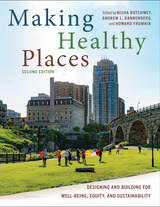
In Making Healthy Places, Second Edition: Designing and Building for Well-Being, Equity, and Sustainability, planning and public health experts Nisha D. Botchwey, Andrew L. Dannenberg, and Howard Frumkin bring together scholars and practitioners from across the globe in fields ranging from public health, planning, and urban design, to sustainability, social work, and public policy. This updated and expanded edition explains how to design and build places that are beneficial to the physical, mental, and emotional health of humans, while also considering the health of the planet.
This edition expands the treatment of some topics that received less attention a decade ago, such as the relationship of the built environment to equity and health disparities, climate change, resilience, new technology developments, and the evolving impacts of the COVID-19 pandemic.
Drawing on the latest research, Making Healthy Places, Second Edition imparts a wealth of practical information on the role of the built environment in advancing major societal goals, such as health and well-being, equity, sustainability, and resilience.
This update of a classic is a must-read for students and practicing professionals in public health, planning, architecture, civil engineering, transportation, and related fields.

Europe became a land of cities during the last millennium. The story told in this book begins with North Sea and Mediterranean traders sailing away from Dorestad and Amalfi, and with warrior kings building castles to fortify their conquests. It tells of the dynamism of textile towns in Flanders and Ireland. While London and Hamburg flourished by reaching out to the world and once vibrant Spanish cities slid into somnlence, a Russian urban network slowly grew to rival that of the West. Later as the tide of industrialization swept over Europe, the most intense urban striving and then settled back into the merchant cities and baroque capitals of an earlier era.
By tracing the large-scale precesses of social, economic, and political change within cities, as well as the evolving relationships between town and country and between city and city, the authors present an original synthsis of European urbanization within a global context. They divide their study into three time periods, making the early modern era much more than a mere transition from preindustrial to industrial economies. Through both general analyzes and incisive case studies, Hohenberg and Lees show how cities originated and what conditioned their early development and later growth. How did urban activity respond to demographic and techological changes? Did the social consequences of urban life begin degradation or inspire integration and cultural renewal? New analytical tools suggested by a systems view of urban relations yield a vivid dual picture of cities both as elements in a regional and national heirarchy of central places and also as junctions in a transnational network for the exchange of goods, information, and influence.
A lucid text is supplemented by numerous maps, illustrations, figures, and tables, and by substantial bibliography. Both a general and a scholarly audience will find this book engrossing reading.
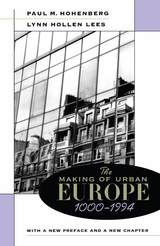
Europe became a land of cities during the last millennium. The story told in this book begins with North Sea and Mediterranean traders sailing away from Dorestad and Amalfi, and with warrior kings building castles to fortify their conquests. It tells of the dynamism of textile towns in Flanders and Ireland. While London and Hamburg flourished by reaching out to the world and once vibrant Spanish cities slid into somnolence, a Russian urban network slowly grew to rival that of the West. Later, as the tide of industrialization swept over Europe, the most intense urban striving settled back into the merchant cities and baroque capitals of an earlier era.
By tracing the large-scale processes of social, economic, and political change within cities, as well as the evolving relationships between town and country and between city and city, the authors present an original synthesis of European urbanization within a global context. They divide their study into three time periods, making the early modern era much more than a mere transition from preindustrial to industrial economies. Through both general analyses and incisive case studies, Paul M. Hohenberg and Lynn Hollen Lees show how cities originated and what conditioned their early development and later growth. How did urban activity respond to demographic and technological changes? Did the social consequences of urban life begin degradation or inspire integration and cultural renewal? New analytical tools suggested by a systems view of urban relations yield a vivid dual picture of cities both as elements in a regional and national hierarchy of central places and also as junctions in a transnational network for the exchange of goods, information, and influence.
A lucid text is supplemented by numerous maps, illustrations, figures, and tables, and by a substantial bibliography. Both a general and a scholarly audience will find this book engrossing reading.
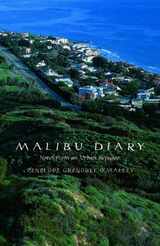
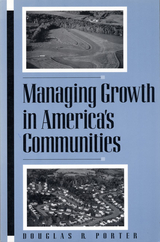
Communities across the country are turning to the concept of "growth management" to help plan for the future, as they seek to control the location, impact, character and timing of development in order to balance environmental and economic needs and concerns. Managing Growth in America's Communities presents practical information about proven strategies, programs and techniques of growth management for urban and rural communities. Topics examined include:
- public roles in community development
- determining locations and character of future development
- protecting environmental and natural resources
- managing infrastructure development
- preserving community character and quality
- achieving economic and social goals
- property rights concerns
Managing Growth in America's Communities is essential reading for community development specialists including government officials, planners, environmentalists, designers, developers, business people, and concerned citizens seeking innovative and feasible ways to manage growth.
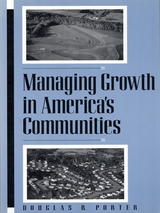
“Growth management” is essential today, as communities seek to control the location, impact, character and timing of development in order to balance environmental and economic needs and concerns. Managing Growth in America's Communities addresses all of the key considerations:
- Establishing public roles in community development;
- Determining locations and character of future development;
- Protecting environmental and natural resources;
- Managing infrastructure development;
- Preserving community character and quality;
- Achieving economic and social goals;
- Respecting property rights concerns.
The author, who is one of the nation’s leading authorities on managing community growth, provides examples from dozens of communities across the country, as well as state and regional approaches. Brief profiles present overviews of specific problems addressed, techniques utilized, results achieved, and contact information for further research. Informative sidebars offer additional perspectives from experts in growth management, including Robert Lang, Arthur C. Nelson, Erik Meyers, and others.
This new edition has been completely updated by the author. In particular, he considers issues of population growth, eminent domain, and the importance of design, especially “green” design. He also reports on the latest ideas in sustainable development, “smart growth,” neighborhood design, transit-oriented development, and green infrastructure planning. Like its predecessor, the second edition of Managing Growth in America's Communities is essential reading for anyone who is interested in how communities can grow intelligently.
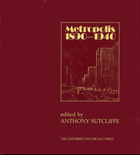
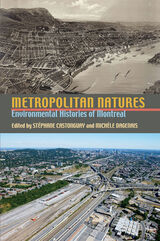
One of the oldest metropolitan areas in North America, Montreal has evolved from a remote fur trading post in New France into an international center for services and technology. A city and an island located at the confluence of the Ottawa and St. Lawrence Rivers, it is uniquely situated to serve as an international port while also providing rail access to the Canadian interior. The historic capital of the Province of Canada, once Canada’s foremost metropolis, Montreal has a multifaceted cultural heritage drawn from European and North American influences. Thanks to its rich past, the city offers an ideal setting for the study of an evolving urban environment.
Metropolitan Natures presents original histories of the diverse environments that constitue Montreal and it region. It explores the agricultural and industrial transformation of the metropolitan area, the interaction of city and hinterland, and the interplay of humans and nature. The fourteen chapters cover a wide range of issues, from landscape representations during the colonial era to urban encroachments on the Kahnawake Mohawk reservation on the south shore of the island, from the 1918–1920 Spanish flu epidemic and its ensuing human environmental modifications to the urban sprawl characteristic of North America during the postwar period.
Situations that politicize the environment are discussed as well, including the economic and class dynamics of flood relief, highways built to facilitate recreational access for the middle class, power-generating facilities that invade pristine rural areas, and the elitist environmental hegemony of fox hunting. Additional chapters examine human attempts to control the urban environment through street planning, waterway construction, water supply, and sewerage.
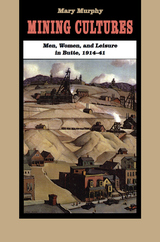
Butte, Montana, long deserved its reputation as a wide-open town. Mining Cultures shows how the fabled Montana city evolved from a male-dominated mining enclave to a community in which men and women participated on a more equal basis as leisure patterns changed and consumer culture grew. Mary Murphy looks at how women worked and spent their leisure time in a city dominated by the quintessential example of "men's work": mining. Bringing Butte to life, she adds in-depth research on church weeklies, high school yearbooks, holiday rituals, movie plots, and news of local fashion to archival material and interviews.
A richly illustrated jaunt through western history, Mining Cultures is the never-told chronicle of how women transformed the richest hill on earth.
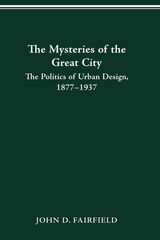
The Mysteries of the Great City examines the physical, cultural, and political transformations of the American city between the Gilded Age and the New Deal. Focusing on New York, Chicago, and Cincinnati, John Fairfield demonstrates that these transformations before and after the advent of city planning were the result of political decisions influenced by corporate and private wealth.
The expansion and reorganization of the great city stood out as the most visible symbol of the transformation. The new metropolitan form, with its skyscraping business center, industrial satellites, crowded working-class neighborhoods, and exclusive suburbs, embodied an emerging corporate order. But the metropolis also disguised the new order and gave it an apparent physical implacability and inevitability that obscured the role of choice in its creation and therefore placed it beyond criticism. Fairfield unravels the mysteries of the new form to reveal the centrality of power and politics in urban design.
While acknowledging that a great many factors shaped urban development, Fairfield underscores the decisive role of human design. He argues that American cities, both before and after the advent of professional planning, have always been in some measure “planned.” Discussing such figures as Frederick Law Olmsted, Henry George, Daniel Burnham, Frederic Howe, Edward Bassett, Robert E. Park, and Louis Wirth, Fairfield illuminates the political and intellectual conflicts among advocates of alternative paths of urban development.
The Mysteries of the Great City will enlighten all readers interested in the development of cities, particularly urban historians and planners. In pointing to the Gilded Age as a period of great possibilities of progressive reform, this study will also reward readers interested in the historical foundations of our modern society.
READERS
Browse our collection.
PUBLISHERS
See BiblioVault's publisher services.
STUDENT SERVICES
Files for college accessibility offices.
UChicago Accessibility Resources
home | accessibility | search | about | contact us
BiblioVault ® 2001 - 2024
The University of Chicago Press









